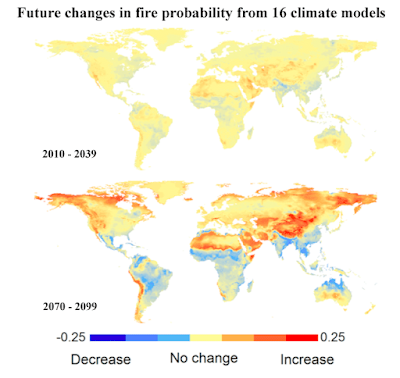Wildfires
Wildfire are typically started accidentally by humans, or by natural causes such as lightening. These 'ignition' events start the fire, however, do not have a major impact on the scale of the fire. It is climate conditions that largely determines the scale ie. precipitation and temperature. The amount of vegetation is also an important factor
(Abatzoglou, 2016).
As areas, have become warmer and drier due to climate change, there has seen an increase wildfires.
Is this climate change?
- Longer fire seasons due to earlier spring snow melt. Summer heat builds up more quickly, and warm conditions extend further into fall.
- Drier conditions will increase the probability of a fire occurring. Higher temperatures, will increase rates of evaporation, and increase wildfire risk areas, where there is lower rates of precipitation.
- Increased frequency of lightning is expected as thunderstorms become more severe.
- More fuel for forest fires through increased insect infestation such as the Mountain pine beetle, from higher temperatures, which results in more dead and high combustible trees.
Future global projections
Figure 1: Predicted fractional change in fire probability for the period 2010-20139 and 2070-2099 for the average of sixteen climate models used for the 2007 IPCC report
Large increases in fires are expected over the globe by the end of this century. For the 2010-2039 period, models predict that 8% of the world will see a decrease in forest fires, whereas 38% will see increases. The models are however, too uncertain to predict fire probability for the other 54%. The decreases are mainly concentrated in the tropics and sub-tropics, and the increase in fires will be predominantly in the biomes with already warm climates. For the 2070-2099 period the magnitude and agreement in the direction of change increases substantially. The models agree that 20% of earth will see decreases, and 62% increases, and models are uncertain for 18% of land areas. The decreases will mainly be in the tropics, and the mid- to high-latitudes are to see increases
(Moritz, 2012).
The
authors found that future fires in many areas will be primarily driven by air moisture availability. Forests in the boreal region are one of the most vulnerable to projected increases in fires. Russian and Canadian boreal forests are at increasing risk due to rapid temperature increases
(stocks, 1998), as well as much of Scandinavia
(Kelly, 2013). In the U.S, the regions which are at most risk from increased fires are the tundra regions of Northern Alaska, and the West, with Arizona and Colorado
(Moitz, 2012).
Western United States
Earlier this year, a study was published in the
Journal Proceedings of the National Academy of Sciences, called
'Impact of Anthropogenic climate change on wildfire across Western US forest'. This study says that human- induced climate change has doubled the amount of area that is affected by forest fires in Western US, in the last 30 years. Due to increased temperatures, which is turning many areas semi- arid and arid, wildfires are spreading across an additional 16,000 sq miles, than they would have otherwise.
The main cause of increase forest fires is attributed to warmer temperatures drying the land, by removing moisture out of plants, trees, dead vegetation, the ground and soil, as warmer air can hold more moisture. Temperature increases, resulting in a drying effect is evident in the rise of more fires. However, the study does state that climate change is not the only factor causing increasing forest fires. Direct human actions, and long- term natural climate oscillations over the pacific ocean, play a role
(Abatzoglou, 2016).
With this being said temperatures are
increasing at around twice the rate in Western US compared to the global warming average. Therefore, climate change should definitely not be dismissed in how big of a factor it is. With wildfire seasons, number of wildfires, and total area affected by wildfires, there has been rapid increases in the past 30/ 40 years, and the future will only see more of these events.
Economic impacts
Since 2010, 10 forest fires in the US have caused at least US$1 billion in damages each, which is mainly from the loss of homes, infrastructure, and firefighting costs. In
2015 across the whole country, wildfires burned > 10 million acres, this is the highest annual total acreage burned since 1960, when recording began. The costliest fire occurred in California, where > 2,500 structures were destroyed in just 2 wildfires. Here insured loses alone exceeded $1 billion.
Other impacts
Beyond the direct economic impacts, there are many other implications of wildfires. Several public health risks are related to wildfires. Smoke reduces air quality and can cause eye and respiratory illness. The young children and the elderly, are at particular risk. A
2012 study estimated that ~340,000 people die each year from long- term health effects, associated with smoke from forest fires.
Wildfires can have ecological implications, causing ecosystem changes. They also release large amounts of co2, which further add to the GHG's already in the atmosphere, and contribute to more climate change. Furthermore, soot that settles on snow and ice cause them to absorb more heat, and therefore melt faster.
Concluding thoughts
Warmer temperatures are causing forest fires to increase, not only in quantity, but also the amount of land that is being affected. We are also seeing prolonged wildfire seasons. However, it is important to realise, as in all cases that climate change is not the only blame. Forest fires can be naturally occurring, and also can be caused by humans, however, the effects of climate change is making this event much more extreme across the globe. Therefore, mitigation and adaptation efforts need to be adopted and put in place immediately, to reduce the risk of wild fires.
The current change in climate in transforming our landscape, and fire is one of the tools it uses. As temperatures rise, we should expect to see more of it, in more places.














